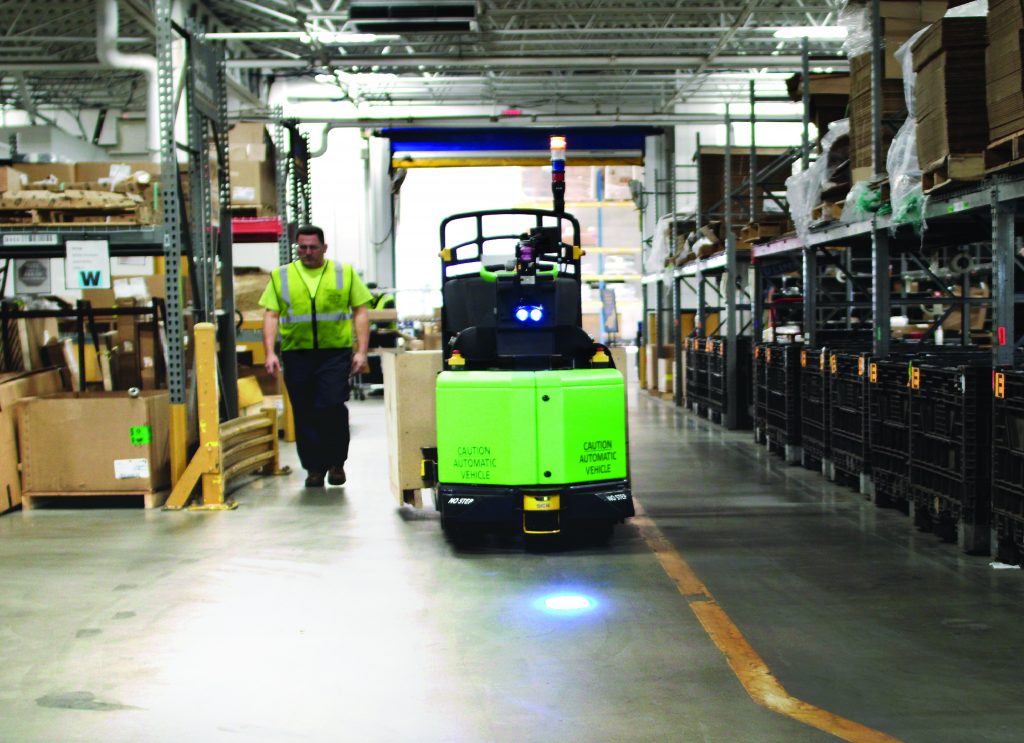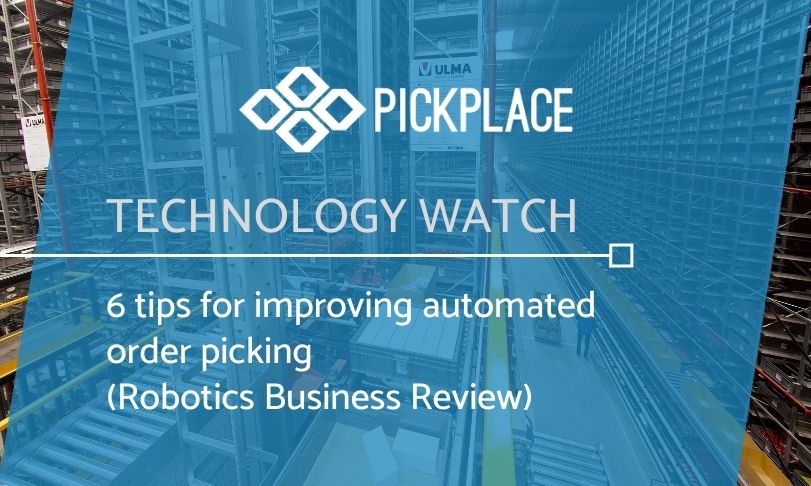Source: Robotics Business Review / by Kayla Matthews
To optimize order picking, robot designers, integrators, and users should consider the pieces, processes, and training required for industrial automation, cobots, or AMRs.

Automated order picking can involve industrial robots, cobots, and mobile robots. Source: Swisslog
A challenging labor market and accelerating customer demand, both exacerbated by the current virus crisis, have put increasing stress on supply chains. As a result, many factories, warehouses, and distribution centers are turning to automated order-picking systems, which can significantly improve throughput and efficiency. However, site managers will see the full benefits of robotics only if they implement these systems properly.
Here are six tips for improving an automated picking system:
1. Design order picking with scalability and flexibility in mind
Global competition and fluctuating market conditions have made flexibility more important than ever for manufacturing and logistics companies. Rising energy costs, supply chain disruptions, and shifting consumer preferences — like growing demand for eco-friendly options — are increasingly common. They can rapidly change the goods a warehouse needs to stock and ship.
Adaptable workflows and facilities can help operators respond to changing market needs and fulfill small-batch or high-variability orders. An automated order-picking system should be able to support seasonal or short-run products, as well as the traditional offerings of a given factory.
For example, GEODIS, UPS, and XPO Logistics have turned to robot rentals to support workers during the holiday rush. Their warehouses hold on to collaborative order-picking and mobile robots while demand is high and workers are overburdened by orders, then return them when they’re no longer needed.
With a system like this, if a warehouse finds that its new order-picking and mobile robots are unnecessary, it’s not difficult to scale back a deployment. If they are needed after the holiday rush, it’s similarly easy to keep these systems working throughout the year.
Designers and integrators should remember that current production needs won’t necessarily stay stable. Warehouse owners and managers typically want to avoid locking their facilities into certain workflows with inflexible or non-scalable decisions.
2. Plan around picking robot limitations
While order-picking robots can offer a range of advantages, they also struggle in some comparisons with human workers. When implementing or reviewing a picking system, warehouse managers should identify challenge areas that may require specialized robots or processes.

Attendees at the ICRA 2019 event watch the FetchIt! Mobile Manipulation Challenge. Image: Fetch Robotics
Some picking robots can struggle with unusually shaped goods. Others will have trouble operating in unstructured environments. Depending on robot type, item weight may be an issue.
For example, while autonomous mobile robots (AMRs) with grippers exist, their uses are typically limited by their low maximum payload — often 10kg (22 lb.) at most. These mobile manipulators may be able to completely automate the picking process for lighter items, but will need to rely on human operators to pick heavier ones.
Warehouses that purchase AMRs may want to invest in a variety of robots with maximum payloads to handle orders of varying weights.
3. Know when to use collaborative robots
While some have seen fully automated order picking as the ultimate goal of warehouse robotics, no one automated solution can currently replace a floor worker.
Some steps of the picking process can easily be fully automated. Others may require the use of both cobots and human workers, or people using heavy equipment.
For instance, collaborative robot arms and gripper might not be fast or precise enough for the desired level of throughput. Or, a particular end-of-arm tool might not be appropriate for different types of products, such as plastic-wrapped apparel, cosmetics bottles, or fragile food items.
While cobots can offer the most flexibility in terms of handling multiple tasks and typically integrate better into existing workflows, they may not be useful in all situations.
4. Design obstacle-free order-picking workspaces
Robots, even those equipped with advanced navigation and machine vision technology, can be slowed down by inefficient workspace design or obstacles.
Managers may need to redesign certain areas or workspaces to ensure robots have the best possible work environment. Simulation software can help in modeling and setting up processes.
Site policies that keep aisles and walkways clear can also help, and safety assessments are crucial. If a warehouse implements cobot arms or AMRs, workers should be trained to stay aware of their surroundings and out of their way. While these robots are designed to work near people, a collision with a worker or piece of heavy equipment can easily cause injury or damage the cobot.
5. Prepare for integration with IT and existing systems
Factory managers should prepare to integrate a new automated order-picking system with existing warehouse management systems and equipment. Where possible, it should build on top of current warehouse and IT workflows.
For example, it may make sense to take advantage of existing equipment and workflows by only partially automating picking. Many factories that want to implement automated systems will already use existing equipment like forklifts that can pick and transport large or unwieldy items. While heavy-duty mobile robots could replace these forklifts, it may be more practical to continue using them alongside automated systems.

GEODIS partner Vecna’s Autonomous Pallet Truck travels alongside a human co-worker. Source: Vecna Robotics
A warehouse in this situation could purchase AMRs to work with human operators in picking smaller items, and reserve robot forklifts for products the AMRs can’t handle.
6. Provide on-site training
IT staff, site managers and floor workers will all need training in how to work with the new picking system. IT staff, for example, will need to know the basics of troubleshooting any new robots or automated data-collection systems. Floor workers, even if they don’t engage directly with the auto picking system, will probably need training in how to work with and around cobots.
Some sites may also need to hire additional skilled staff to operate and maintain elements of the automated picking system. Warehouses that purchase robots, for example, may need to bring on technicians to perform basic maintenance or help program and test new robots.
Optimizing a site’s automated order-picking system
Low unemployment rates and rising demand have warehouses turning to automated systems. When implemented well, they can improve throughput and boost efficiency. However, it’s also possible to suffer from common pitfalls that can prevent these systems from running as well as they could.
Warehouse managers that want to implement picking systems should design for responsiveness to fluctuations in demand. They should also consider common challenges of automated picking systems — like the limitations in robot gripper systems — when implementing a new method.

